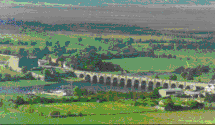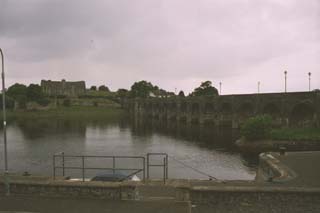 Info
- The village of Shannonbridge is named
after the bridge built in 1757 which spanned the river connecting
county Offaly and county Roscommon. The village
has recently run a small jazz festival, and a vintage car rally and a
boat regatta stop in the village during the summer months. The village
is close to Clonmacnois, a site world famous for the ancient monastic
buildings found there, and is about 8 miles from the town of Athlone. Info
- The village of Shannonbridge is named
after the bridge built in 1757 which spanned the river connecting
county Offaly and county Roscommon. The village
has recently run a small jazz festival, and a vintage car rally and a
boat regatta stop in the village during the summer months. The village
is close to Clonmacnois, a site world famous for the ancient monastic
buildings found there, and is about 8 miles from the town of Athlone.
Shannonbridge has two major attractions – angling and ecology. The peat bogs
which surround the village are home to an abundance of flora and
fauna, and is preserved as a natural habitat to the now rare
corncrake. Also along the river are eskers, which are winding ridges
of raised ground caused by melting ice during the Ice Age and were
used by early settlers to cross the river. The proximity to the peat
bog influenced the building of Irelands largest peat burning power
station at Shannonbridge.
History - It’s said that the first town of Shannonbridge was
built by the military to protect the ford in the river. The remains of
the nineteenth century Napoleonic fortifications found at
Shannonbridge are considered to be a unique example of fortifications
of the period. They were completed in 1817 at a cost of £30,000. There
was originally a lock here, but the Shannon commissioners decided to
remove it and dredge a channel in the 1840’s.
 Our bit - Shannon Bridge is the first place to cross the Shannon south of Athlone, and more importantly the first
watering hole if travelling by boat. The bridge is certainly high enough to allow all boats through but
did have a swing bridge mechanism at one time which can still be seen next to the moorings below the
bridge. There is limited mooring by the bridge, and additional mooring in a cut further down stream.
This however does require a walk through the fields to reach the village. Anyone mooring here should
ensure they have adequate lighting with them if they intend to use these moorings after dark.
Our bit - Shannon Bridge is the first place to cross the Shannon south of Athlone, and more importantly the first
watering hole if travelling by boat. The bridge is certainly high enough to allow all boats through but
did have a swing bridge mechanism at one time which can still be seen next to the moorings below the
bridge. There is limited mooring by the bridge, and additional mooring in a cut further down stream.
This however does require a walk through the fields to reach the village. Anyone mooring here should
ensure they have adequate lighting with them if they intend to use these moorings after dark.
|